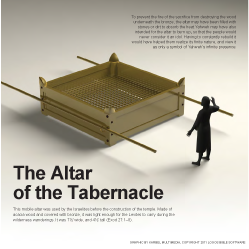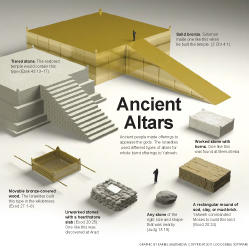16:1–34 Leviticus 16 describes the rituals for the Day of Atonement, known in Jewish tradition as Yom Kippur. |
16:1 had come near before Yahweh and they died The main legal sections in chs. 1–16 are broken up by a few narrative segments that move along the story begun in Exodus and continued in Numbers. The laws about the sacrificial system in chs. 1–7 set the framework for the inauguration of the priesthood in chs. 8–10. Similarly, the purity laws in chs. 11–15 set the framework for this account of the Day of Atonement ceremony. This verse explicitly connects the instructions of ch. 16 with the events of ch. 10, where Aaron’s sons Nadab and Abihu died in the tabernacle for violating procedure (see note on 10:1–20). The detailed procedure for the Day of Atonement was needed to prevent a similar tragedy from happening again.
16:2 at any time The priest was only allowed into the holy of holies—where the ark of the covenant was kept—on this day.
he might not die Yahweh’s presence made the inner chamber of the tabernacle a dangerous place. In biblical passages where Yahweh has appeared to people, they often fear that they will die from having been in the presence of God (e.g., Gen 32:30; Exod 33:20; Judg 13:21–22).
16:3 a sin offering The Hebrew word used here—chatta’th—refers to the purification offering, which was the primary blood atonement sacrifice in the Levitical system. See Lev 4:1–5:13 and note.
a burnt offering An offering where the entire animal was burned on the altar. See 1:3–17 and note.
16:4 a holy linen tunic The high priest would cover himself with white linen. The garments Aaron was to wear are detailed in Exod 28:40–43.
16:6 he shall make atonement See note on Lev 4:20. The basic idea of atonement is to purge impurity.
is to purge impurity.
16:8 shall cast lots A divination method for determining the will of a deity, widely used in the ancient Near East. References to casting lots are found in both the ot and nt (Josh 18:8; Prov 16:33; Acts 1:26).
are found in both the ot and nt (Josh 18:8; Prov 16:33; Acts 1:26).
 Old Testament Theology and Divination
Old Testament Theology and Divination
for Yahweh The goat designated for Yahweh was the one used to purge the sanctuary (v. 9). Aaron’s own purging would be accomplished by a bull (v. 6).
for Azazel The second goat was not sacrificed; it was driven out of the camp after the high priest symbolically transferred the sins of the nation to it.
16:10 to make atonement for himself Atonement is typically associated with blood sacrifice—the guilt (trespass) offering (asham in Hebrew) and the purification (sin) offering (chatta’th in Hebrew). Here, atonement is connected with the goat to be sent away—alive. No blood is applied to the goat or associated with this part of the ritual (Lev 16:20–22). In this special case, making atonement may either refer to the confession in v. 21 or to the overall purpose of the day’s rituals. See 4:20 and note.
16:11 the sin offering’s bull, which is for himself Aaron first offered a bull as a chatta’th (or purification offering) to purify himself and his household (v. 6). This allowed him to enter the sanctuary.
16:12 from behind the curtain The Day of Atonement was the only time the priest could go beyond the veil (curtain) that separated the front room of the tent (or later the temple) from the inner room (the most holy place or holy of holies).
16:13 he shall put the incense on the fire The high priest must put the incense on the small altar stationed in front of the veil leading to the most holy place, where the ark of the covenant was kept (see Exod 30:1).
on the small altar stationed in front of the veil leading to the most holy place, where the ark of the covenant was kept (see Exod 30:1).
might cover the atonement cover The site where God’s presence was directly manifested needed to be obscured by a cloud of incense. The lid of the ark of the covenant was called in Hebrew the kapporeth, which is commonly translated as “atonement cover” or “mercy seat” (see note on Exod 25:17).
16:14 he shall take some of the bull’s blood The high priest went behind the veil (curtain) twice—first to sprinkle the blood from the bull used for his own purification (sin) offering and then to sprinkle the blood from the goat that was the people’s purification (sin) offering (Lev 16:15). The blood of this goat made the people ritually clean before Yahweh—but their sins had not yet been removed. Blood was the agent of purification in sacrifice (4:6, 17; Num 19:4).
from the goat that was the people’s purification (sin) offering (Lev 16:15). The blood of this goat made the people ritually clean before Yahweh—but their sins had not yet been removed. Blood was the agent of purification in sacrifice (4:6, 17; Num 19:4).
16:16 for the sanctuary Atonement is made for the sanctuary—an inanimate object—as well as for people. The high priest also makes atonement for the altar and the tabernacle in general (Lev 16:20). Compare v. 33.
is made for the sanctuary—an inanimate object—as well as for people. The high priest also makes atonement for the altar and the tabernacle in general (Lev 16:20). Compare v. 33.
16:18 altar that is before Yahweh The large sacrificial altar in the courtyard of the tabernacle (see Exod 27:1–8).
16:20 he shall present the living goat After the blood of the goat for Yahweh was sprinkled inside the tabernacle, the ritual shifts focus to the second goat. This goat was not sacrificed.
16:21 on the living goat’s head After the purging of the sanctuary by the sacrificial blood, the second act of the Day of Atonement ritual came into focus: ridding the camp of its sins via the goat for Azazel (see note on Lev 16:8). On the symbolic gesture of laying on hands, see note on 1:4.
he shall confess The Hebrew verb yadah (“confess”) has the sense of “revealing”—the opposite of concealing. The Israelites were to name their sins.
all their sins The collective guilt of the community for all of their sins is symbolically transferred to the goat who will carry the sin away.
16:22 the goat shall bear on it to a barren region all their guilt The live goat carried away the sins of the congregation. This goat—not the goat that was sacrificed—was the one connected with the sins of the people.
he shall send the goat away The goat was not free to wander; it was driven far enough from the camp that it could not return.
16:26 the person who sends out the goat The person who leads the goat into the wilderness becomes ritually impure. This impurity is similar to that caused by contact with a carcass in Lev 11:24–25. Although alive, the goat is treated as though it were dead.
16:29 on the tenth of the month The date designated for the Day of Atonement is specified here in the Hebrew text as the tenth day of the month Tishri (the seventh month). Tishri was an autumn month.
 Israelite Calendar Table
Israelite Calendar Table
 Israelite Festivals Table
Israelite Festivals Table
16:33 he shall make atonement for the sanctuary’s holy place See v. 16 and note.

|
About Faithlife Study BibleFaithlife Study Bible (FSB) is your guide to the ancient world of the Old and New Testaments, with study notes and articles that draw from a wide range of academic research. FSB helps you learn how to think about interpretation methods and issues so that you can gain a deeper understanding of the text. |
| Copyright |
Copyright 2012 Logos Bible Software. |
| Support Info | fsb |
 Loading…
Loading…


